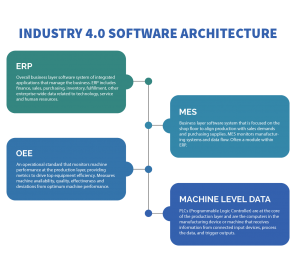The Challenges
Industry 4.0 or the fourth industrial revolution is going on all around us, changing the way technology affects the manufacturing and industrial world and shaping the economic future. A new generation of “smart factories,” acting on machine-level data in a constant stream of connected operations, is at the heart of Industry 4.0 and for those who are ready for it, will result in smarter businesses, operating at optimum efficiency and producing high-quality outcomes.
Companies moving to the 4.0 business model will face new challenges ahead. In future blog posts, we’ll be discussing how to position your organization for the next generation so watch this space for critical information on:
- Defining your Industry 4.0 strategy – Top Down v. Bottom Up
- Capturing the real ROI of Industry 4.0 – ROI you can see today and not ten years from now
- The new paradigm for evaluating and procuring Industry 4.0 solutions that work
- Structuring your organization to maximize outcomes
- The interconnection of all departments and what it means to your manufacturing process.
We’re setting the groundwork on some important basic concepts and components of the smart factory and how they converge in an Industry 4.0 business model.
Architecture
Industry 4.0 is the term used to describe the automation of information and the integrated exchange of data in manufacturing technology. It takes into account the digitalization of machines, cloud computing, and the Internet of Things (IoT), integrating the physical and the software in both the business layer and the production layer of manufacturing. The concept has evolved into what is becoming known as the “smart factory.” Deloitte defines the smart factory this way:
“A smart factory can integrate data from systemwide physical, operational, and human assets to drive manufacturing, maintenance, inventory tracking, digitization of operations through the digital twin, and other types of activities across the entire manufacturing network.”
At its most simplistic level, a smart factory is one where the machines and software are linked together by digital devices that allow the manufacturing process to adapt based on input from business systems. These include systems like Enterprise Resource Planning (ERP) and MES (Manufacturing Execution Systems) at the business layer and Overall Equipment Effectiveness (OEE) and Machine Level Data (MLD) at the production layer.

Performance optimization at the production layer is the Key to becoming the smarter and more efficient business that Industry 4.0 promises, and is our focus at Automation Intellect. Without this critical benchmark of what’s possible on your plant floor, you cannot measure improvement. So let’s take a deeper dive into OEE and its impact on the Industry 4.0 business model.
